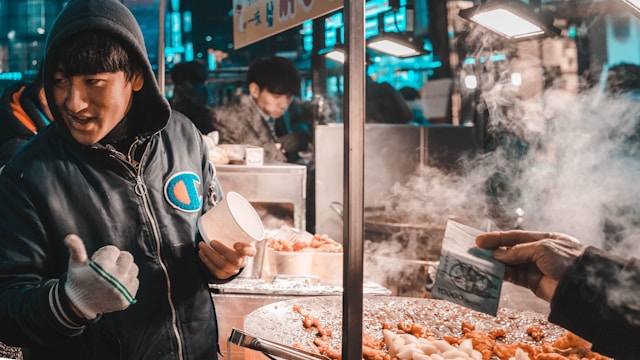
Seoul, the vibrant capital of South Korea, has emerged as a global culinary destination that celebrates both its traditional heritage and contemporary innovations. From bustling street markets to elegant fine dining establishments, Seoul offers an unrivaled gastronomic experience that reflects its rich history and dynamic modernity. This article explores the essence of Seoul’s culinary journey, diving deep into the flavors, culture, and stories that make it a must-visit destination for food enthusiasts.
The Essence of Korean Street Food: A Cultural Exploration
Seoul’s street food is the heartbeat of its culinary culture. Wander through Myeongdong, Gwangjang Market, or Hongdae, and you’ll find a symphony of flavors wafting through the air. These vibrant hubs are where locals and visitors converge to enjoy inexpensive yet delectable treats.
- Tteokbokki (Spicy Rice Cakes): This iconic dish, with its chewy rice cakes and spicy-sweet gochujang (red chili paste) sauce, is a staple in street food stalls across Seoul.
- Hotteok (Sweet Pancakes): Filled with cinnamon, brown sugar, and nuts, these fried pancakes are a favorite snack, especially during colder months.
- Gimbap (Seaweed Rice Rolls): Often likened to sushi, gimbap is a portable snack made with rice, vegetables, and sometimes meat or fish, all rolled in seaweed.
- Eomuk (Fish Cake Skewers): Served in hot broth, these skewers are perfect for a quick, comforting bite.

Street food markets also offer a window into Korean culinary traditions, where recipes are handed down through generations. The interactive experience of watching vendors prepare your meal adds a unique charm.
Traditional Korean Cuisine: Honoring Heritage and Authenticity
At the heart of Seoul’s culinary identity lies traditional Korean cuisine, steeped in centuries of history. Dining at a hanjeongsik (Korean full-course meal) restaurant is an immersive experience that showcases the country’s dedication to balance, harmony, and health.
- Kimchi: No Korean meal is complete without kimchi. This fermented vegetable dish, typically made with napa cabbage and radishes, is spiced with garlic, ginger, and red pepper flakes.
- Bibimbap: A harmonious mix of rice, sautéed vegetables, gochujang, and often a fried egg or sliced meat, bibimbap exemplifies the concept of balance in Korean cooking.
- Samgyeopsal (Grilled Pork Belly): Commonly enjoyed in Korean barbecue settings, this dish is cooked at the table and paired with lettuce wraps and ssamjang (spicy dipping sauce).
- Samgyetang (Ginseng Chicken Soup): A hearty soup made with whole chicken stuffed with rice, ginseng, and jujubes, samgyetang is traditionally consumed during summer for its restorative properties.
These dishes not only highlight unique flavors but also reflect the importance of seasonality and communal dining in Korean culture.
Seoul’s Fine Dining Scene: Culinary Innovation at Its Best
In recent years, Seoul has positioned itself as a hub for fine dining, with Michelin-starred restaurants and experimental chefs redefining Korean cuisine. This evolution blends traditional ingredients with modern techniques, creating a global culinary conversation.
- Jungsik: With two Michelin stars, Jungsik reimagines Korean food as “New Korean Cuisine,” offering dishes like bibim salad and jangachi rice served with artistic finesse.
- Gaon: Awarded three Michelin stars, Gaon focuses on elevating traditional recipes using premium ingredients and meticulous preparation.
- Mingles: Known for its inventive approach, Mingles merges Korean and Western flavors, presenting dishes like soy-marinated foie gras and jang-based desserts.
The fine dining scene in Seoul not only attracts locals but also international food lovers eager to experience Korean flavors in a refined setting.
Fusion and Global Influences: Seoul as a Culinary Melting Pot
Seoul’s culinary landscape thrives on its ability to embrace global influences while staying true to its roots. The city’s dynamic food scene includes a plethora of fusion restaurants where East meets West.
- Korean-Mexican Tacos: Marrying kimchi and bulgogi with traditional taco shells, these fusion delights have gained immense popularity.
- Italian-Korean Pasta: Creamy pastas infused with gochujang or topped with seaweed flakes highlight creative cross-cultural dishes.
- American-Korean Fried Chicken: Known for its crispy exterior and flavorful sauces, Korean fried chicken has taken the world by storm.
Seoul’s ability to innovate while maintaining a strong sense of identity has made it a pioneer in global culinary trends.
Drinks and Desserts: Sweet and Spirited Delights
No exploration of Seoul’s culinary journey is complete without savoring its drinks and desserts.
- Makgeolli (Rice Wine): This slightly sweet, milky rice wine is a beloved traditional drink often enjoyed with savory pancakes or jeon.
- Soju: Korea’s most popular spirit, soju pairs perfectly with barbecue and is a staple of social gatherings.
- Bingsu (Shaved Ice Dessert): Topped with sweetened condensed milk, fruits, or red beans, bingsu is a refreshing dessert popular during summer.
- Street Stall Desserts: From dalgona candy to fish-shaped bungeoppang filled with red bean paste or custard, Seoul’s dessert offerings are both nostalgic and inventive.
The Role of Culture and Community in Seoul’s Food Scene
Food in Seoul is more than just sustenance; it is a reflection of community and cultural pride. Korean culinary traditions emphasize sharing and togetherness, whether in bustling street food stalls or elegant fine dining restaurants. Festivals like the Kimchi-Making Festival further emphasize the communal spirit, inviting locals and tourists to partake in the joy of Korean food culture.
Practical Tips for Exploring Seoul’s Culinary Scene
To make the most of your gastronomic journey in Seoul, here are some practical tips:
- Visit Street Markets Early: Arriving early ensures you get the freshest food and avoid long queues.
- Reserve Fine Dining in Advance: Michelin-starred restaurants often have waiting lists, so plan accordingly.
- Learn Basic Korean Phrases: Simple phrases like “mashisseoyo” (it’s delicious) can enhance your dining experience.
- Follow Local Recommendations: Trust locals for hidden gems and authentic experiences.
Seoul’s culinary journey is a testament to its ability to honor tradition while embracing innovation. Whether you’re sampling street food or indulging in fine dining, the city offers a gastronomic adventure like no other.